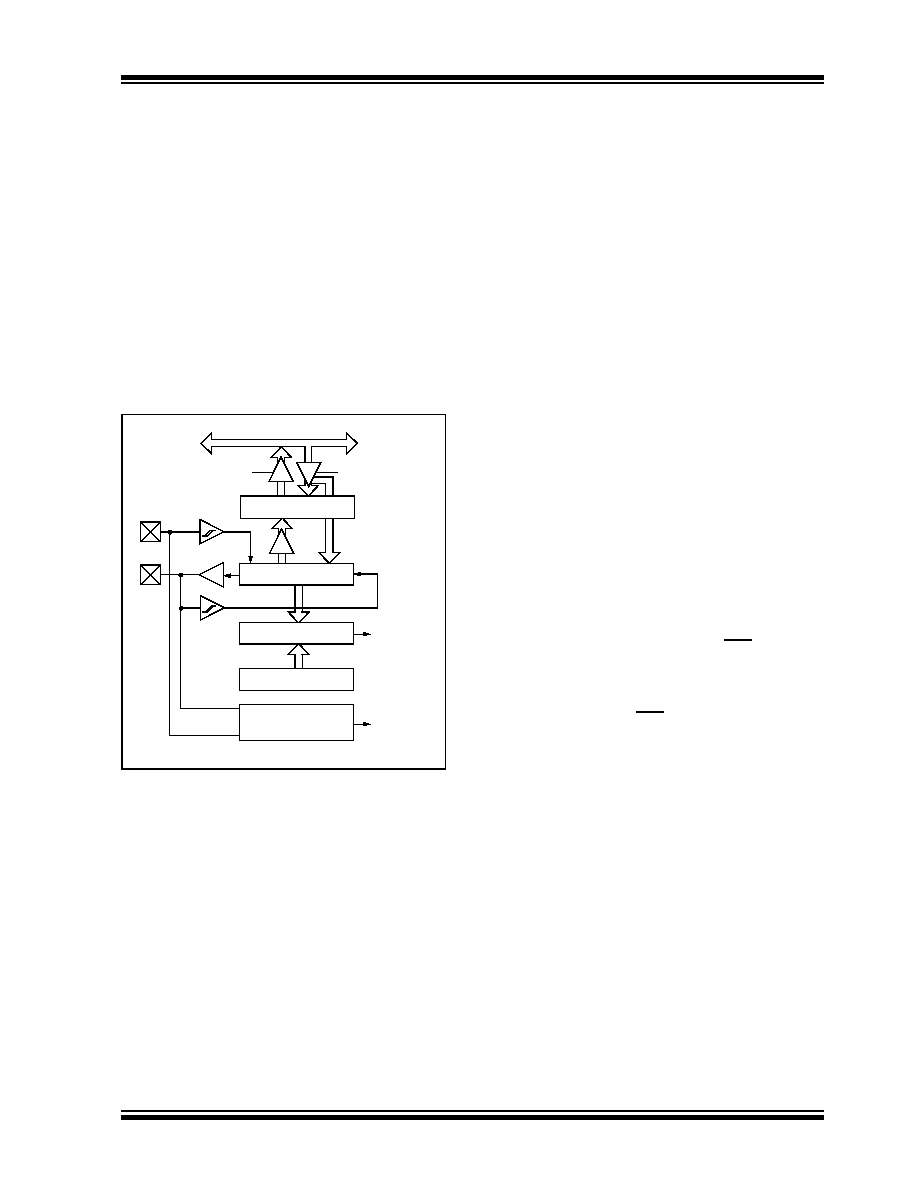- 您現(xiàn)在的位置:買賣IC網(wǎng) > PDF目錄1919 > ENC624J600T-I/PT (Microchip Technology)IC ETHERNET CTRLR W/SPI 64-TQFP PDF資料下載
參數(shù)資料
| 型號(hào): | ENC624J600T-I/PT |
| 廠商: | Microchip Technology |
| 文件頁(yè)數(shù): | 133/168頁(yè) |
| 文件大?。?/td> | 0K |
| 描述: | IC ETHERNET CTRLR W/SPI 64-TQFP |
| 視頻文件: | Fast 100 Mbps Ethernet PICtail Plus Overview |
| 標(biāo)準(zhǔn)包裝: | 1,200 |
| 控制器類型: | 以太網(wǎng)控制器(IEEE 802.3) |
| 接口: | SPI |
| 電源電壓: | 3 V ~ 3.6 V |
| 電流 - 電源: | 96mA |
| 工作溫度: | -40°C ~ 85°C |
| 安裝類型: | 表面貼裝 |
| 封裝/外殼: | 64-TQFP |
| 供應(yīng)商設(shè)備封裝: | 64-TQFP(10x10) |
| 包裝: | 帶卷 (TR) |
| 配用: | AC164132-ND - BOARD DAUGHTER PICTAIL ETHERNET |
第1頁(yè)第2頁(yè)第3頁(yè)第4頁(yè)第5頁(yè)第6頁(yè)第7頁(yè)第8頁(yè)第9頁(yè)第10頁(yè)第11頁(yè)第12頁(yè)第13頁(yè)第14頁(yè)第15頁(yè)第16頁(yè)第17頁(yè)第18頁(yè)第19頁(yè)第20頁(yè)第21頁(yè)第22頁(yè)第23頁(yè)第24頁(yè)第25頁(yè)第26頁(yè)第27頁(yè)第28頁(yè)第29頁(yè)第30頁(yè)第31頁(yè)第32頁(yè)第33頁(yè)第34頁(yè)第35頁(yè)第36頁(yè)第37頁(yè)第38頁(yè)第39頁(yè)第40頁(yè)第41頁(yè)第42頁(yè)第43頁(yè)第44頁(yè)第45頁(yè)第46頁(yè)第47頁(yè)第48頁(yè)第49頁(yè)第50頁(yè)第51頁(yè)第52頁(yè)第53頁(yè)第54頁(yè)第55頁(yè)第56頁(yè)第57頁(yè)第58頁(yè)第59頁(yè)第60頁(yè)第61頁(yè)第62頁(yè)第63頁(yè)第64頁(yè)第65頁(yè)第66頁(yè)第67頁(yè)第68頁(yè)第69頁(yè)第70頁(yè)第71頁(yè)第72頁(yè)第73頁(yè)第74頁(yè)第75頁(yè)第76頁(yè)第77頁(yè)第78頁(yè)第79頁(yè)第80頁(yè)第81頁(yè)第82頁(yè)第83頁(yè)第84頁(yè)第85頁(yè)第86頁(yè)第87頁(yè)第88頁(yè)第89頁(yè)第90頁(yè)第91頁(yè)第92頁(yè)第93頁(yè)第94頁(yè)第95頁(yè)第96頁(yè)第97頁(yè)第98頁(yè)第99頁(yè)第100頁(yè)第101頁(yè)第102頁(yè)第103頁(yè)第104頁(yè)第105頁(yè)第106頁(yè)第107頁(yè)第108頁(yè)第109頁(yè)第110頁(yè)第111頁(yè)第112頁(yè)第113頁(yè)第114頁(yè)第115頁(yè)第116頁(yè)第117頁(yè)第118頁(yè)第119頁(yè)第120頁(yè)第121頁(yè)第122頁(yè)第123頁(yè)第124頁(yè)第125頁(yè)第126頁(yè)第127頁(yè)第128頁(yè)第129頁(yè)第130頁(yè)第131頁(yè)第132頁(yè)當(dāng)前第133頁(yè)第134頁(yè)第135頁(yè)第136頁(yè)第137頁(yè)第138頁(yè)第139頁(yè)第140頁(yè)第141頁(yè)第142頁(yè)第143頁(yè)第144頁(yè)第145頁(yè)第146頁(yè)第147頁(yè)第148頁(yè)第149頁(yè)第150頁(yè)第151頁(yè)第152頁(yè)第153頁(yè)第154頁(yè)第155頁(yè)第156頁(yè)第157頁(yè)第158頁(yè)第159頁(yè)第160頁(yè)第161頁(yè)第162頁(yè)第163頁(yè)第164頁(yè)第165頁(yè)第166頁(yè)第167頁(yè)第168頁(yè)

2007 Microchip Technology Inc.
DS21993C-page 65
PIC16CR7X
9.3
SSP I2C Operation
The SSP module in I2C mode fully implements all slave
functions except general call support, and provides
interrupts on Start and Stop bits in hardware to facilitate
firmware implementations of the master functions. The
SSP module implements the standard mode specifica-
tions as well as 7-bit and 10-bit addressing.
Two pins are used for data transfer. These are the RC3/
SCK/SCL pin, which is the clock (SCL), and the RC4/
SDI/SDA pin, which is the data (SDA). The user must
configure these pins as inputs or outputs through the
TRISC<4:3> bits.
The SSP module functions are enabled by setting SSP
enable bit SSPEN (SSPCON<5>).
FIGURE 9-5:
SSP BLOCK DIAGRAM
(I2C MODE)
The SSP module has five registers for I2C operation.
These are the:
SSP Control Register (SSPCON)
SSP Status Register (SSPSTAT)
Serial Receive/Transmit Buffer (SSPBUF)
SSP Shift Register (SSPSR) – Not directly
accessible
SSP Address Register (SSPADD)
The SSPCON register allows control of the I2C opera-
tion. Four mode selection bits (SSPCON<3:0>) allow
one of the following I2C modes to be selected:
I2C Slave mode (7-bit address)
I2C Slave mode (10-bit address)
I2C Slave mode (7-bit address), with Start and
Stop bit interrupts enabled to support Firmware
Master mode
I2C Slave mode (10-bit address), with Start and
Stop bit interrupts enabled to support Firmware
Master mode
I2C Start and Stop bit interrupts enabled to
support Firmware Master mode, Slave is Idle
Selection of any I2C mode with the SSPEN bit set,
forces the SCL and SDA pins to be open drain, pro-
vided these pins are programmed to inputs by setting
the appropriate TRISC bits. Pull-up resistors must be
provided externally to the SCL and SDA pins for proper
operation of the I2C module.
Additional information on SSP I2C operation can be
found in the “PIC Mid-Range MCU Family Reference
Manual” (DS33023).
9.3.1
SLAVE MODE
In Slave mode, the SCL and SDA pins must be config-
ured as inputs (TRISC<4:3> set). The SSP module will
override the input state with the output data when
required (slave-transmitter).
When an address is matched, or the data transfer after
an address match is received, the hardware automati-
cally will generate the Acknowledge (ACK) pulse, and
then load the SSPBUF register with the received value
currently in the SSPSR register.
There are certain conditions that will cause the SSP
module not to give this ACK pulse. They include (either
or both):
a)
The Buffer Full bit BF (SSPSTAT<0>) was set
before the transfer was received.
b)
The overflow bit SSPOV (SSPCON<6>) was set
before the transfer was received.
In this case, the SSPSR register value is not loaded
into the SSPBUF, but bit SSPIF (PIR1<3>) is set.
Table 9-2 shows what happens when a data transfer
byte is received, given the status of bits BF and
SSPOV. The shaded cells show the condition where
user software did not properly clear the overflow condi-
tion. Flag bit BF is cleared by reading the SSPBUF
register, while bit SSPOV is cleared through software.
The SCL clock input must have a minimum high and
low for proper operation. The high and low times of the
I2C specification, as well as the requirements of the
SSP module, are shown in timing parameter #100 and
parameter #101.
Read
Write
SSPSR Reg
Match Detect
SSPADD Reg
Start and
Stop bit Detect
SSPBUF Reg
Internal
Data Bus
Addr Match
Set, Reset
S, P bits
(SSPSTAT Reg)
RC3/SCK/SCL
RC4/
Shift
Clock
MSb
SDI/
LSb
SDA
相關(guān)PDF資料 |
PDF描述 |
|---|---|
| EP1AGX90EF1152I6 | IC ARRIA GX FPGA 90K 1152FBGA |
| EP1C3T144A8N | IC CYCLONE FPGA 2910 LE 144-TQFP |
| EP1K100FC484-1N | IC ACEX 1K FPGA 100K 484-FBGA |
| EP1S80F1020C5N | IC STRATIX FPGA 80K LE 1020-FBGA |
| EP1SGX40GF1020I6 | IC STRATIX GX FPGA 40K 1020-FBGA |
相關(guān)代理商/技術(shù)參數(shù) |
參數(shù)描述 |
|---|---|
| ENC680D05B | 制造商:未知廠家 制造商全稱:未知廠家 功能描述: |
| ENC680D-05B | 制造商:未知廠家 制造商全稱:未知廠家 功能描述:STD MOV |
| ENC680D07B | 制造商:未知廠家 制造商全稱:未知廠家 功能描述: |
| ENC680D-07B | 制造商:未知廠家 制造商全稱:未知廠家 功能描述:STD MOV |
| ENC680D10B | 制造商:未知廠家 制造商全稱:未知廠家 功能描述: |
發(fā)布緊急采購(gòu),3分鐘左右您將得到回復(fù)。